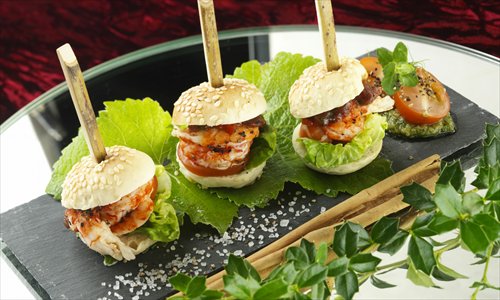Foreigners discuss the different ways of eating freshwater lobster and the culinary cultures behind them

Spicy and other Chinese-style crawfish titillate the taste buds of foreigners living and traveling in the Middle Kingdom. Photo: CFP
Matthew Rea has eaten crawfish in Beijing, Shanghai, Chongqing, Chengdu, Sichuan Province, and many other places in China.
The first time he tried the Chinese version of his favorite seafood, the hot and spicy crawfish, he immediately loved the dish.
"I like the spice," he said, adding that there was a big difference in taste from what he is used to in the US.
In China, the crawfish is usually first laid out in the restaurant, pre-cooked, and then cooked again for more flavor, Rea said.
Coming from Louisiana in the US, a place known for its long celebrated history of crawfish delicacies, Rea thinks it's great that Chinese foodies have made crawfish the latest star of their snack culture.
"While [the Chinese way adds] more flavor, it also makes the meat chewier. In Louisiana, we just cook them once, and the meat is tender," he said.
"So, there's a trade-off between spice and texture; I like both."
Rea has been living in China since 2008. In 2013, he co-founded Ruijin Cajun restaurant in Shanghai, which serves authentic Cajun and Creole food. He is opening a new location right next door to a Chinese place that does Chinese-style crawfish.
Rea hopes that the two crawfish cooking styles and two businesses could be complementary.
Crawfish is a freshwater shellfish that resembles a small lobster. It is considered a delicacy by many and has become increasingly popular in China over the last decade, especially as a nighttime snack.
Every summer, the crawfish becomes a hot topic, with lots of media reports and posts discussing its popularity, its rising prices every year, and whether the shellfish is an internationally shared delicacy. So, the Metropolitan invited foreigners to discuss the beloved food.


Many countries, including Sweden, China, the US and Canada, enjoy crawfish during the summer. Photos: IC, CFP
Different tastes
"One of the major differences is that we eat it as a kind of afternoon barbecue. The Chinese almost exclusively eat crawfish after dinner as a late night snack," said Rea.
On Saturday, July 2, Rea hosted a crawfish boil with a live band, up to 100 people, a barbecue, beers, and crawfish dishes.
The event, an exotic experience for many, was also familiar to many homesick people like Rea. In Louisiana, a crawfish boil is a big social event that often gathers dozens of family members and friends and goes on for hours.
"We have been eating them for a couple of hundreds of years now," Rea said.
"We dump the crawfish out on a big table, and everybody stands around. We also boil corn, garlic, potato and sausage, and people stand around in the backyard or a park, eating and socializing and drinking beer, listening to blues or jazz music."
Cajun cuisine was developed by the French-speaking Canadians deported by the British to Louisiana. One of the signature Cajun crawfish dishes from Louisiana is the Crawfish Étouffée, which features crawfish meat cooked with vegetables, very rich savory sauce, pepper, celery, onion and butter, and served with rice.
The dish has been one of the bestsellers over the last year at the restaurant, with half of its customers being foreigners.
Another is the crawfish pie, which is good for snacking and splitting with people as an appetizer, said Rea.
Having started from doing crawfish boils at festivals, now, Rea hopes to make the crawfish boil a weekly event every Saturday afternoon.
Food that pulls people together
Richelle Gamlam, 25, a college counselor in Beijing and a food and travel blogger, fell in love with crawfish when she had it for the first time at a coworker's house.
Most of the crawfish that Gamlam had were Zhejiang-style because at the time she lived in Ningbo, Zhejiang Province.
"There's not a lot of seasoning, but it's really good," said Gamlam, who comes from Seattle in the US. "They sell it on the side of the road, and you sit at the little tables and on the small stools."
What she loves, she said, is more the Chinese street food culture than the flavor itself. She would gather a group of friends and go to have crawfish or barbecue in the evening.
Gamlam said in Seattle, people often have steak, salmon or hamburger barbecues in the summer afternoons.
As far as she can tell, many Americans and some Europeans living in China would find the idea of having crawfish at night appealing.
"It's a social experience that I really enjoy. It's similar to hotpot, with everybody reaching out and eating from the middle of the table," she said.
One of the most important reasons crawfish is loved all over the world is its ability to pull people together. Making a social event out of eating crawfish is not limited to China or the US. In Sweden, the Swedes have their traditional crawfish parties or the kräftskiva in August.
"For a crawfish party, you need plenty of crawfish, bread, beer, often a cheese pie, and very often vodka. That's it!" said Anne Skoogh, a food blogger who lives in Stockholm, Sweden.
"I think it's the crawfish parties that's fun, not so much the actual crawfish itself," she said.
In the age of online chatting, the promise of crawfish can make people drop their phones and connect with people offline.
"It's salty and spicy and takes a long time to peel and eat. People drink beer while they are eating them," Rea said.
"You've got your hands occupied. You don't have time for your phone. So you can actually connect with the people that you are at the table with."
A crowd favorite the world over
Ku Chi-fai, the Chinese executive chef at Yu, a Chinese Restaurant at The Ritz-Carlton, Beijing, said that while a lot of Canadians and Americans would usually grill or boil crawfish with spices like vanilla, the Chinese crawfish cooking methods seem more colorful.
Most Western methods would want to preserve the original taste of the crawfish itself, but the Chinese prefer to cook it with strong sauces, such as pepper and fermented soy bean sauce, Ku explained.
"You've got your creamy crawfish, steamed and braised crawfish, and your crawfish sautéed with ginger and scallion - a popular way to cook seafood in Cantonese cuisine," he said. "And above all, the hot and spicy crawfish."
According to him, the spicy kind is not only the most popular among Chinese customers right now, but it would also be the most attractive flavor for expats and foreigners visiting China.
"Spicy food is appetizing and often a signature of Chinese cuisine in foreigners' eyes," he said.
It seems that the Chinese consumers' appetite for crawfish is through the roof. Restaurants are popping up everywhere.
Beijing has its Guijie food street, which features dozens of the hottest crawfish restaurants. Shanghai has its Shouning Lu, known as the "crawfish street" to locals.
And several cities in China, including Xuyi in Jiangsu Province, and Guiyang in Guizhou Province, host crawfish festivals every year where tens of tons of crawfish are consumed.
Hubei Province consumed 247,000 tons of crawfish in 2015, with a business output value of 33 billion yuan ($4.9 billion), according to a People's Daily website report in October 2015.
On top of the growing consumption in the domestic market, China has become one of the largest crawfish exporters, with the US, Japan, and Europe being its top destinations. China's largest crawfish export base, Qianjiang in Hubei Province, exported $190 million worth of crawfish in 2015, a recent report from the Xinhua News Agency said.
"Sweden imports most of its crawfish from China, Spain or Turkey, where it's prepared especially for the Swedish market, with Swedish recipes," Skoogh said.
As the Swedish way of eating crawfish is cooking it with dill and sugar, Skoogh sometimes buys ready-peeled crawfish tails in brine imported from China, and uses them for various recipes, such as couscous with crawfish tails and halloumi cheese and mushroom, and crawfish pasta.
Affordable delicacy
While munching on crawfish every summer has been a tradition for decades or even centuries in Nordic countries, Louisiana, as well as China's Jiangsu Province and other places, its recent nationwide popularity as a nighttime snack might be a result of promotion, according to Ku.
"Food trends in China are often by fits and starts, and Chinese consumers tend to follow the trend," he said.
Another reason, Ku said, is that in recent years, people have been "feeling bored about regular meat and trying to find something new and special to snack on."
Meanwhile, crawfish, whose Chinese name literally translates into "small lobsters," offer a comparatively new and titillating taste at an affordable price.
However, as its popularity increases, so does its price.
Rea also noticed the changing price. "They are so much more expensive in China now," he said.
About 500 grams of crawfish costs about 50 to 60 yuan in China. The same amount of precooked would cost about $2 in a supermarket in Louisiana, according to Rea.
But it seems that the rising price hasn't changed people's appetite, at least, not for now. Nowadays, many people are staying up at night to watch Eurocup live, and restaurants and food delivery services provide crawfish and beer combo specials to satiate their appetite while they take in the sport.
"Most of the best food in the world come from foods that are eaten out of necessity. When people couldn't afford shrimp, they would eat crawfish," said Rea.
"Crawfish are just one of those magical foods that are discovered likely by accident and turn out to be a delightful thing to eat."
Newspaper headline: Crazy for crawfish